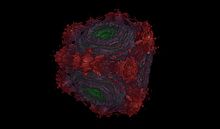- Mandelbulb
-
The Mandelbulb is a three-dimensional analogue of the Mandelbrot set, constructed by Daniel White and Paul Nylander using spherical coordinates.[1]
A canonical 3-dimensional Mandelbrot set does not exist, since there is no 3-dimensional analogue of the 2-dimensional space of complex numbers. It is possible to construct Mandelbrot sets in 4 dimensions using quaternions. However, this set does not exhibit detail in all dimensions like the 2D Mandelbrot set.
White and Nylander's formula for the "nth power" of the 3D vector
 is
is
where

They use the iteration
 where z^n is defined as above and a+b is a vector addition.[2] For n > 3, the result is a 3-dimensional bulb-like structure with fractal surface detail and a number of "lobes" controlled by the parameter n. Many of their graphic renderings use n = 8.
where z^n is defined as above and a+b is a vector addition.[2] For n > 3, the result is a 3-dimensional bulb-like structure with fractal surface detail and a number of "lobes" controlled by the parameter n. Many of their graphic renderings use n = 8.Contents
Quadratic formula
Other forumulae come from identities which parametrise the sum of squares to give a power of the sum of squares such as:
- (x2 − y2 − z2)2 + (2xz)2 + (2xy)2 = (x2 + y2 + z2)2
which we can think of as a way to square a triplet of numbers so that the modulus is squared. So this gives, for example:
or various other permutations. This 'quadratic' formula can be applied several times to get many power-2 formula.
Cubic formula
Other forumulae come from identities which parametrise the sum of squares to give a power of the sum of squares such as:
- (x3 − 3xy2 − 3xz2)2 + (y3 − 3yx2 + yz2)2 + (z3 − 3zx2 + zy2)2 = (x2 + y2 + z2)3
which we can think of as a way to cube a triplet of numbers so that the modulus is cubed. So this gives:
or other permutations.
for example. Which reduces to the complex fractal
 when z=0 and
when z=0 and  when y=0.
when y=0.There are several ways to combine two such `cubic` transforms to get a power-9 transform which has slightly more structure.
Quintic formula
Another way to create Mandelbulbs with cubic symmetry is by taking the complex iteration formula
 for some integer m and adding terms to make it symmetrical in 3 dimensions but keeping the cross-sections to be the same 2 dimensional fractal. (The 4 comes from the fact that i4 = 1.) For example, take the case of
for some integer m and adding terms to make it symmetrical in 3 dimensions but keeping the cross-sections to be the same 2 dimensional fractal. (The 4 comes from the fact that i4 = 1.) For example, take the case of  . In two dimensions where z = x + iy this is:
. In two dimensions where z = x + iy this is:This can be then extended to three dimensions to give:
for arbitrary constants A,B,C and D which give different Mandelbulbs (usually set to 0). The case
 gives a Mandelbulb most similar to the first example where n=9. An more pleasing result for the fifth power is got basing it on the formula:
gives a Mandelbulb most similar to the first example where n=9. An more pleasing result for the fifth power is got basing it on the formula:  .
.Power Nine formula
This fractal has cross-sections of the power 9 Mandelbrot fractal. It has 32 small bulbs sprouting from the main sphere. It is defined by, for example:
These formula can be written in a shorter way:
and equivalently for the other coordinates.
Spherical Formula
A perfect spherical formula can be defined as a formula:
where
- (x2 + y2 + z2)n = f(x,y,z)2 + g(x,y,z)2 + h(x,y,z)2
where f,g and h are nth power rational trinomials and n is an integer. The cubic fractal above is an example.
Taffy
Shapes with long strands are commonly described as looking like taffy and are considered less appealing.
Idealised 3D Mandelbrot Fractal
In the fractal community an idealised 3D Mandelbrot is considered to resemble a hierarchy of spheres just as the 2D Mandelbrot resembles a hierarchy of circles. The branch like structures of the 2D Mandelbrot should become twig-like structures of the 3D Mandelbrot. Such a fractal is considered the 'Holy Grail' of 3D fractal art.
See also
References
External links
Categories:- Fractals
Wikimedia Foundation. 2010.























